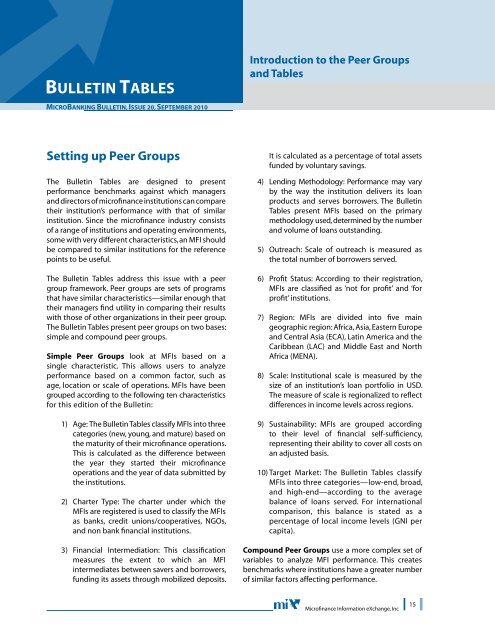THE MICROBANKING BULLETIN No. 20 - Microfinance Information ...
THE MICROBANKING BULLETIN No. 20 - Microfinance Information ...
THE MICROBANKING BULLETIN No. 20 - Microfinance Information ...
You also want an ePaper? Increase the reach of your titles
YUMPU automatically turns print PDFs into web optimized ePapers that Google loves.
<strong>BULLETIN</strong> TABLESIntroduction to the Peer Groupsand Tables<strong>MICROBANKING</strong> <strong>BULLETIN</strong>, Issue <strong>20</strong>, SepteMBER <strong>20</strong>10Setting up Peer GroupsThe Bulletin Tables are designed to presentperformance benchmarks against which managersand directors of microfinance institutions can comparetheir institution’s performance with that of similarinstitution. Since the microfinance industry consistsof a range of institutions and operating environments,some with very different characteristics, an MFI shouldbe compared to similar institutions for the referencepoints to be useful.The Bulletin Tables address this issue with a peergroup framework. Peer groups are sets of programsthat have similar characteristics—similar enough thattheir managers find utility in comparing their resultswith those of other organizations in their peer group.The Bulletin Tables present peer groups on two bases:simple and compound peer groups.Simple Peer Groups look at MFIs based on asingle characteristic. This allows users to analyzeperformance based on a common factor, such asage, location or scale of operations. MFIs have beengrouped according to the following ten characteristicsfor this edition of the Bulletin:1) Age: The Bulletin Tables classify MFIs into threecategories (new, young, and mature) based onthe maturity of their microfinance operations.This is calculated as the difference betweenthe year they started their microfinanceoperations and the year of data submitted bythe institutions.2) Charter Type: The charter under which theMFIs are registered is used to classify the MFIsas banks, credit unions/cooperatives, NGOs,and non bank financial institutions.3) Financial Intermediation: This classificationmeasures the extent to which an MFIintermediates between savers and borrowers,funding its assets through mobilized deposits.It is calculated as a percentage of total assetsfunded by voluntary savings.4) Lending Methodology: Performance may varyby the way the institution delivers its loanproducts and serves borrowers. The BulletinTables present MFIs based on the primarymethodology used, determined by the numberand volume of loans outstanding.5) Outreach: Scale of outreach is measured asthe total number of borrowers served.6) Profit Status: According to their registration,MFIs are classified as ‘not for profit’ and ‘forprofit’ institutions.7) Region: MFIs are divided into five maingeographic region: Africa, Asia, Eastern Europeand Central Asia (ECA), Latin America and theCaribbean (LAC) and Middle East and <strong>No</strong>rthAfrica (MENA).8) Scale: Institutional scale is measured by thesize of an institution’s loan portfolio in USD.The measure of scale is regionalized to reflectdifferences in income levels across regions.9) Sustainability: MFIs are grouped accordingto their level of financial self-sufficiency,representing their ability to cover all costs onan adjusted basis.10) Target Market: The Bulletin Tables classifyMFIs into three categories—low-end, broad,and high-end—according to the averagebalance of loans served. For internationalcomparison, this balance is stated as apercentage of local income levels (GNI percapita).Compound Peer Groups use a more complex set ofvariables to analyze MFI performance. This createsbenchmarks where institutions have a greater numberof similar factors affecting performance.<strong>Microfinance</strong> <strong>Information</strong> eXchange, Inc15
















